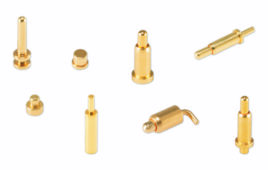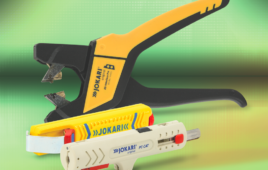by Todd Walter, National Instruments
If the Industrial Internet of Things (IIoT) takes off, machines will depend on free flowing data within and between other machines. Updates to standard Ethernet will support these needs.
In the U.S. alone industrial machines are an over $200-billion market. This competitive market has undergone an evolution in the last 30 years, shifting from primarily mechanical designs to mechatronic software driven designs. Today intelligent systems control multiple independent motion axes providing flexibility and minimizing mechanical maintenance. A modern industrial machine is a networked, coordinated system consisting of many axes of motion, multiple specialized sensors, cameras, and power contactors, all controlled by multiple high-performance CPUs.

Machines perform a number of tasks during manufacturing. The next stage in improving productivity, speed and accuracy will require knowing more about all machine and component interactions. Thus, the IIoT is seen as a key component of this evolution.
But a number of business pressures face developers of industrial machines.
• Customization: The final customer often expects the machine builder to customize the machine operation to meet their specific needs. This may be integration of the machine into the other equipment in their facility, changes to physical dimensions, modifications to the HMI, or integration of additional hardware or software capabilities. The challenge is to respond to these customers’ requests while minimizing engineering expenses and avoiding service challenges down the road.
• Competition: Machines create the products a company sells, so increased throughput means more product revenue. In some industries these machines are also major cost contributors through energy usage. To remain competitive, machine design must constantly focus on increasing throughput, reducing scrap and improving efficiency.
• New approaches: Beyond continuous improvement, there are also opportunities for radical changes in approach. New business models are emerging that are based on consumables or on service. In these models, the builder uses secure two-way communication with the machine for just-in-time consumable supply and machine productivity based billing.
• Availability: End users are managing operational costs by reducing their maintenance staffs. Thus, machine design requires an infrastructure for fault logging, remote debugging, remote reporting and remote management. Remote management can eliminate the time and cost incurred from a technician travelling to the customer site and the remote reporting provides advanced warning of failures and can reduce unplanned downtime.

Even though every manufacturing facility uses multiple buses to transmit specific types of data, typically, they all have Ethernet in common.
An example: semiconductor machinery
For reference, consider equipment used for semiconductor production. Semiconductor production machines perform multiple chemical and photo-lithographic steps where electronic circuits are created on a wafer of silicon. This wafer is then tested, cut into individual chips, and then the chips are packaged to provide electrical contact points and to allow for thermal management. The cost of producing and processing a silicon wafer is high. To minimize the cost per chip, designers optimize the size of chips and the distance between the chips on the wafer. This design, coupled with smaller, 22- and 14-nm semiconductor processes, allows designers to pack many chips onto a single wafer. The step where the wafer is cut to produce multiple chips is called wafer dicing. To handle the tightly packed chips, the wafer-dicing machine makes precise cuts with precision measured in 1⁄1000 of a mm.

Updated standard Ethernet should improve data collection and machine tool to component interaction.
To achieve the required dicing accuracy, a typical implementation uses precise dicing blades or lasers to etch and cut the wafer. This cutting is controlled with high-performance motion control axes often using fast responding mechanisms like voice coil motors or multi-axes galvanometers for laser control. These axes get inputs from high-resolution absolute position feedback mechanisms. Machine vision is now sometimes also used in the main control loop to assure proper position. These performance axes are sometimes augmented with vibration feedback to adjust for small movements of the system. The sensors are read by the controller. These data become inputs into sophisticated control algorithms, and the cutting motion adjusted many thousands of times per second. This control loop must be deterministic and precisely timed. Around this core function of the machine there are additional tasks, such as coordinated multi-axes motion, to load the wafer and unload the cut chips. Many machines use vibration or power quality measurements as part of predictive maintenance. The system normally has a local user interface where an operator can interact with the machine and has connections to the manufacturing logistics and enterprise systems.
The design of this machine involved multiple processing, actuation and input nodes. To minimize point-to-point wiring, these nodes pass control data, configuration information and process statistics across a set of communication busses. In most modern machines, there is a hierarchy of busses, each optimized for their specific function. Since the heart of the machine is the motion axes, examine these needs first.
To meet the stability and reliability requirements of high-speed, closed-loop motion control, a motion bus needs to consistently deliver the control packets between the drives/sensors and the controller with a latency of less than 100 µsec. The motion axes also need to be coordinated so time synchronization between the nodes of less than 1 µsec is needed.
Standard shared Ethernet cannot guarantee this performance as the potential queuing time in the switches will be too high. These fast control loops typically run on an infrastructure connected using Ethernet physical layer and CAT5 cabling with modified hardware in the nodes and bridges to eliminate queuing and provide latency bounding. Other discrete sensors and actuators are often also serviced by this motion bus.
Cameras require high bandwidth and can cause congestion problems on a shared media. Typically, cameras will run on a dedicated standard Ethernet link, a USB 3.0 connection, or may use a vision specialized serial bus. The controllers and HMI are connected using standard Ethernet; this same bus may be used to integrate the machine into the larger manufacturing process where it directly communicates with neighboring machines. This connection also provides integration into the overall plant MES system and mechanisms for remote connection to the original machine builder’s maintenance and service systems.
Technical challenges
A system design with multiple bus layers has led to a situation where Ethernet is common in control applications, but where a typical machine supports multiple versions of Ethernet, each optimized to meet the requirements of a specific task. This technical approach leads to a set of challenges for the machine designer:
• Bandwidth limitations. Because many of the busses optimized latency by modifying the hardware layers, these busses do not directly benefit from the increased performance of standard Ethernet. Industrial adoption of 1 to 10 GB/sec bandwidth allows control applications to share more data and incorporate more complex sensing such as high fidelity vision, 3D part or area scans, and vibration measurement.
• Limited data within the machine. The multiple non-interoperable busses in a high-performance machine cannot directly pass data between them. Instead software services run on controllers or gateway devices to provide proxy and tunneling capabilities. Unfortunately, these software services impose performance limitations and the lack of standardization makes configuration of data transfer difficult. Eliminating these barriers would increase performance and usability.
• Limited remote access. When a machine is malfunctioning at a customer facility, machine builders now need the ability to easily probe all aspects of the machine to diagnose and repair the problem. To accomplish this they need to integrate cleanly into the end customer IT infrastructure and support a secure remote connection. This remote connection is most useful if it extends to the lowest levels of the device to get diagnostic data, real-time views, and to support reconfiguration tasks. But multi-bus designs restrict the machine designer’s access, potentially complicating and extending repair.
Beyond the benefits of simpler system integration, validation and maintenance, there is increased value and urgency to eliminate the layers and barriers of traditional machine design.
IoT concepts promise to increase productivity, increase up-time and improve other key performance indicators.
Techniques such as remote system management, centralized data collection for big data analytics, and built-in, self-organizing, machine-to-machine coordination, could radically advance next generation industrial control and monitoring systems. To support these capabilities, industrial designers need reliable, converged, remote, secure access to all the components and devices in their designs. This goal requires fundamental improvements to standard Ethernet so that it will concurrently support both industrial control needs and IoT connectivity and data access.
Updates to standard Ethernet
Ethernet is defined in a family of standards referred to as IEEE 802. IEEE 802 is an open standards group with active participation from individuals around the globe. The IEEE 802 standards specify requirements for the different layers and functions of Ethernet and assure interoperability between different vendors.
802.11 is a set of standards defining WiFi. Other relevant standards include 802.3, which specifies the physical and MAC capabilities for Ethernet, and 802.1, which specifies the functions of Ethernet switches. Industrial suppliers, IT vendors and silicon providers are collaborating in IEEE 802 to create updates to standard Ethernet that will serve the needs of industrial machine designers by providing bounded low latency data transfer for control, shared synchronized time and high bandwidth. With these updates, standard Ethernet will offer the industrial market:
• Convergence — One standard Ethernet backbone that will support both low-latency, high-reliability control data, as well as concurrently support other Ethernet traffic. Because the high reliability class of traffic is managed and protected, additions of ;other traffic cannot interfere with the control data and do not create the need for revalidation. This eliminates the data barriers and enables both in-machine data sharing and IoT capabilities for remote access. It also simplifies the engineering development process by allowing designers to focus on the same core infrastructure.
• Performance — Standard Ethernet is constantly improved through large investment every year by both major silicon and IT companies and specialty protocol organizations. This investment has led to increased bandwidth, increased interoperability and decreased commissioning time. The improvements to standard Ethernet to support control traffic will become part of this on-going technology investment. The control traffic class will support deterministic transfer measured in 10 sec of µsec, time synchronization between nodes measured in 10 sec of nsec, and automatic configurations for high reliability redundant data paths.
• Cost — The commercial use of Ethernet drives very high volumes and lowers the price of the components. By using standard Ethernet components, the cost of the end devices and the IT infrastructure is lower compared to using specialty Ethernet variants based on lower volume ASIC or FPGA based implementations.
Many industrial application protocols have already been adapted to standard Ethernet. This does not mean they can coexist on the same network. Coexistence requires cooperation and this cooperation can occur at the end device, be forced within the network, or a combination of both. For the network to enforce coexistence, all network devices must be compatible. This level of compatibility requires interoperability specifications and certification testing much as the WiFi alliance has done for 802.11 and all its variants.
An organization such as AVnu can provide the labeling to give end users confidence and the specifications required to pull together the family of standards that will assure that networks can meet the demands of the various applications.
National Instruments
www.ni.com
AVnu Alliance
www.avnu.org
This material was adapted from a white paper from AVnu Alliance.
Filed Under: CONNECTIVITY • fieldbuses • networks, Machine tools + subtractive manufacturing, MORE INDUSTRIES





Tell Us What You Think!